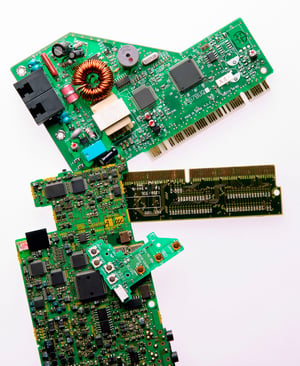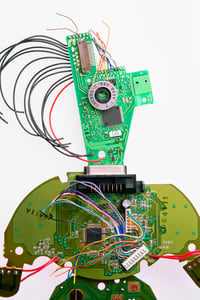 The world of networking changes – fast. Here’s a look at the history of networking technologies that no longer exists, with a bit of why the technology is happily gone.
The world of networking changes – fast. Here’s a look at the history of networking technologies that no longer exists, with a bit of why the technology is happily gone.
- Frame Relay – MPLS came in with lower costs, lower latencies, QoS and more reliability. (source)
- Half-Duplex Ethernet – Having collisions occur was just part of normal Ethernet until low-cost Ethernet switches created dramatic improvements to LAN performance. (source)
- 10Base-5 Ethernet – This required Vampire Tap Connections into the thick ethernet coax cabling. These connections were not very reliable, as you could lose connectivity until you wiggled it appropriately to re-gain communications. 10Base-2 improved the reliability considerably. (source)
- 10Base-2 Ethernet – If you ever split the network, or forgot to properly terminate the end of the network, you had a lot of unhappy users. 10Base-T with twisted pair cabling and hubs made the network far more reliable. (source)

- Acoustic Coupler Modems – These modems would have you manually dial the remote phone number, and when you hear the far end screech its 300baud signal, you would put the phone handset inside the coupler and hope that the modem synchronized. The integrated modem replaced this, as it could be programmed to dial the number and synchronize far more reliably. (source)
- Point-to-Point Circuits – Packet switched networks like X.25, Frame Relay, and MPLS replaced this technology, as there was far more flexibility with network design at a far lower cost. (source)
- Modems – For those of us who remember the screeches of modems every time you tried to connect to the Internet, it was part of regular operation for the mid-90s. High speed Internet doomed modems rapidly in the early 2000s. (source)
- BBS – Bulletin Board Systems were all the rage in the late 80s and early 90s. You could use your phone to connect to single-line or rare multi-line BBS systems all over the country – watch out for the expensive long-distance toll charges, or be prepared to do some phreaking to avoid the costs. Internet websites rapidly replaced BBSes in the mid 90s. (source)
- ISDN – Integrated Services Digital Network: This all-digital technology was intended to be the next upgrade from POTS lines for remote connectivity, but it never took off due to it being too expensive and complex for wide usage. Because of its limited use, many folks said that the acronym stood for “It Still Does Nothing”. High speed Internet from cable and DSL providers killed this technology. (source)
- T1 circuits – These 1.544mbps serial circuits were highly reliable and used the existing CAT3 cabling that was ubiquitous around the world for many decades. The technology died in the early 2000s as metro-Ethernet offered far faster speeds and required less specialized hardware. (source)
- Multiprotocol routers – Old routers needed to support routing IP packets, but also Novell IPX/SPX and Appletalk packets. If you had to support these routers, it was challenging because of the complexities of each of these other protocols that could create problems for some users, but not others. In the end, IP won the day and we are all happier as a result. (source)
- Appletalk – This protocol was designed to be simple, autoconfiguring, and not require servers or other specialized services to work. These benefits also created drawbacks, as Appletalk tended to be very “chatty” and not use bandwidth efficiently (Appltalk broadcast storm anyone?). IP was a better solution for both LAN and WAN usage despite it needing a DHCP server to operate. (source)
- IPX/SPX – Novell created this protocol to work smoothly on LANs and be efficient for moving larger blocks of data in a low-latency environment. Its Achilles heel was when you had to use it across WAN links with high latency. It was very slow due to the fact that it did not have the sliding windows capability of TCP/IP. IP worked just as well in the LAN, but had far better performance in the WAN which caused it to win in the end. (source)
- Token Ring – Having IBM back this technology had a number of people think that it would be the LAN technology that would win in the end. The drawback was that the adapters cost a lot more than an inexpensive ethernet NIC, and specialized cabling and expensive hubs were needed to keep this technology around. (source)
- X.25 Networks – This was created in the late 70s as a WAN-based packet switched network that would also help grow IP as a protocol riding on top. It had a lot of overhead to deal with loss (circuits back then ran over poor grade cabling and had a lot of single-bit errors to deal with). As circuits got more and more reliable, the overhead was no longer needed, and less expensive Frame-Relay took over. (source)
- Serial connections – Having to configure a serial line meant you had to match both sides with the same speed, data bits setting, parity choice, and stop bits. Typically, you would see a circuit configured for 9600, 8, N, 1 meaning: 9600 bits per second, 8 data bits, no parity, and 1 stop bit. Metro Ethernet happily clobbered this tech with faster speeds and easier setup. (source)
- CSU/DSUs – If you remember what B8ZS or ESF stands for, I’ll buy you a beer next time we see each other in person. Configuring these units was sometimes challenging if your Telco provider didn’t get you proper documentation on the circuit buildout. Metro Ethernet replaced these with faster and easier to configure circuits. (source)
- POTS – Plain Old Telephone Service: This is your grandmother’s phone with a dial. This used to be valuable for dial-backup to get into routers and networks when the network equipment was misbehaving, but it’s mostly dead at this point, killed by multiple technologies: low-cost high speed Internet, Wireless, and cellular networks. (source)
- On-prem PBXes – This only recently made a departure from the picture (if you still have one, it’s probably starting to get hard to get parts). Most of these have been abandoned as there are hundreds of hosted VoIP companies who can provide this service at a very low cost. (source)
- Desktop PCs – The only place that these are found is home computers that are high-end gaming systems, or for kiosk computers where a different person may sit and run the computer (bank teller, or government office). (source)
- 10mbps Ethernet – 10Base-T was far easier to work with and less expensive than Token Ring or Arcnet, and it’s performance was also faster. It lost to Fast Ethernet (100Base-T) due to more performance and the possibility of full-duplex communications. (source)
- Fast Ethernet – Nobody buys a 10/100 Ethernet switch anymore because it’s less than $20 to buy a gigabit switch. (source)
- AUI & MAU – In order to connect to an Ethernet network, you would connect a MAU (Media Attach Unit) to your computer’s AUI connector. You would get a different MAU depending on what type of media you were attaching: 10Base2, 10Base5, or 10BaseT. Since 10BaseT won in the end, MAUs were built into the NIC so no separate hardware was needed. (source)
- Arcnet – This technology used a token-passing mechanism similar to Token-Ring, but was far less expensive. Adapters were inexpensive (33% the cost of a Token-Ring adapter), and did not require expensive cabling or expensive hubs. Its drawback was that performance was quite poor for a LAN technology (2.5mbps). Ethernet won due to it being inexpensive and having far better performance. (source)
- PRI Circuits – Phone systems used to live or die based on these super-stable (but expensive) connectivity to the PSTN. SIP Trunks ended up replacing the vast majority of these (they are still out there but are on their way out). (source)
- FDDI – Fiber Distributed Data Interface networks required a dual ring to be built with fiber-optic connections. It had incredible performance at the time, but died due to expensive NICs, difficult to work with cabling (when’s the last time you spliced fiber?), and low-cost FastEthernet matching its performance. (source)
- Bus networks – Dealing with snaking the long cable through a building’s wiring system, and painful troubleshooting caused this technology to die. “The network is down until I can find where the network is split” was often the angst of many network engineers. (source)
- Coax cabling – Cutting the coax cable and splicing in BNC connectors just to add a T connector for a new user might take 15 minutes if you are efficient. A 20 minute downtime on the network to perform this activity was particularly painful if it was done in the middle of the day. Star networks won by making it easy to connect new users. (source)
- Bridges – These were an absolute requirement if you had Ethernet and Token-ring in your network. They were expensive, but helped to connect different network types, and could also improve Ethernet performance by segregating traffic to one side of the network. It was killed by low-cost Ethernet switches. (source)
- BNC connectors – If you ran 10Base-2, 10Base-5, or Coax Arcnet, you had to fight with these connectors. Properly adding a connector was a challenging ordeal, and you only knew it was done right if the network worked after you did it. Twisted pair and RJ-45 connectors won because they were easier to work with and more reliable to use. (source)
- Token-passing networks – In theory, having equal access to the medium was a fair way to allocate network resources. The drawback is that as networks got larger, it took significant time for all the quiet computers to say “I have nothing to say” just to let two computers talk. Ethernet with its CSMA/CD won because of performance. (source)
- Layer-2 QoS – Adding frame-level QoS tagging (802.1p priority) was a way to have switches give priority to properly tagged traffic. In the end, it was too complicated to implement for many networks, and the solution was easy and inexpensive: add more LAN bandwidth. With most voice streams occupying less than 32Kbps, there’s ample space on a gigabit connection to not get crowded out. (source)
- Ethernet Hubs – Hubs were a fantastic improvement from the Coax bus networks that it replaced, but they were quickly shelved when low-cost Ethernet switches became available. (source)
- Proxy server firewalls – These firewalls were awesomely secure because they wouldn’t pass through viruses or EXE files, but could not be used with any streaming audio or video. They passed the torch to packet-filtering firewalls. (source)
- Packet filtering firewalls – These firewalls were great for streaming and browsing, but weren’t very smart. They would still allow a lot of bad things through, so they’re mostly limited to residential use nowadays. Most all businesses use Next Generation firewalls that include application aware firewalling capabilities. (source)
- Workgroup Servers – The day and age when a workgroup server sat running inside a broom closet has happily come to an end. All of these were decommissioned when their functions were moved to the cloud. (source)
- MPLS – Some companies might argue that MPLS is not dead…yet… With the dramatic advance of SD-WAN and ultra-reliability of high-speed Internet throughout the country, MPLS’s days have come to an end except under specific circumstances where performance guarantees are required. (source)
- ATA – Analog Telephony Adapters: These were used when you had an old POTS analog phone or fax and needed to connect to a more modern VoIP network. They created problems with voice quality (underwater garble sound due to the analog-to-digital conversions). Happily, most are eWaste now. (source)
- FAX – Remember getting phone calls with a fax tone beeping in your ear? Remember how long it would take to get 5 pages to go through? Remember having to properly format and print your fax cover sheet to have the right information on it? All gone thanks to document scanning and emails. (source)
- Rotary Phones – In the old days, you used to have to “dial” each number with an actual dial. You always hated people who had a lot of nines or zeroes in their number because it slowed down your dialing. Touch-tone phones with DTMF replaced this. (source)
- Long distances charges – When calling across the country, you had to be very careful how long the call was due to the fact that these calls incurred a significant charge. Businesses had large monthly bills that had to be reviewed to insure that costs were not out of control. With free worldwide communications now available via VoIP and UC, nobody worries about this anymore. (source)
- Centrex – The old school way of avoiding managing your own PBX was to purchase Centrex: A centrally managed PBX with POTS lines out to your office desk phones. This solution was far more expensive than hosted VoIP. (source)
Just for fun…
In networking, Carrier Pigeon is still considered a valid emergency backup for when the primary network is down. This standard continues to be updated, so it is not considered a dead technology. See: IP over Avian Carriers, and China's Most Secret Weapon: The Messenger Pigeon.
On the telecom side, Tin Can & String is the equivalent emergency backup technology and is thus not considered dead. (source)
Pneumatic tubes (source) were long-since relegated to the dead pile, but looks to make a comeback with transporting people and cargo via Hyperloop (source)
If you want to become a faster, more efficient troubleshooter, check out our white paper on identifying and resolving the root cause of network problems.





